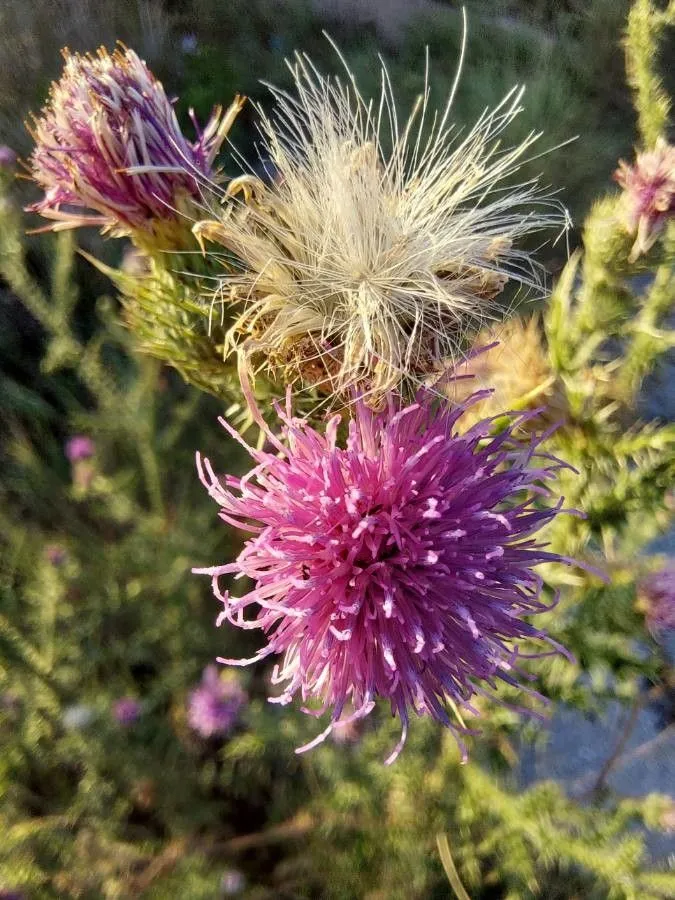
Author: L.
Bibliography: Sp. Pl.: 821 (1753)
Year: 1753
Status: accepted
Rank: species
Genus: Carduus
Vegetable: Unknown
Observations: Temp. Eurasia
The welted thistle, scientifically known as Carduus acanthoides, is a prominent member of the Asteraceae family. This resilient plant is native to temperate regions of Eurasia, where it thrives in a variety of environments. The welted thistle has been acknowledged and documented since 1753, as evidenced by its inclusion in scholarly botanical records such as “Sp. Pl.: 821.”
Carduus acanthoides is easily identifiable by its spiny appearance and purplish flower heads, which bloom during the summer months. These thistles are biennial, meaning they typically complete their life cycle over two years. In the first year, they form a rosette of leaves close to the ground, and in the second year, they develop a tall, erect flowering stem that can reach up to 1.5 meters in height.
The plant’s leaves are deeply lobed and lined with sharp spines, making it a formidable presence in its natural habitat. These spines serve as a defense mechanism against herbivores, ensuring the plant’s survival and reproduction. The flower heads of the welted thistle are composed of numerous tiny florets, which collectively create a vibrant display that attracts pollinators such as bees and butterflies.
Given its hardy nature and adaptability, the welted thistle can often be found in disturbed sites, pastures, and roadsides. However, due to its aggressive growth and tendency to dominate landscapes, it is considered a weed in many regions. Control measures are often necessary to prevent it from overwhelming local flora and disrupting ecological balances.
Despite its reputation as an invasive species, the welted thistle plays an important role in its native ecosystem. It provides shelter and food for various insects and wildlife. Furthermore, traditional medicine has made use of thistles for their purported health benefits, although such uses should be approached with caution due to the plant’s spiny characteristics and potential for causing irritation.
In summary, Carduus acanthoides, or the welted thistle, is a distinctive and hardy plant that commands attention both for its beauty and its resilience. While it poses certain challenges as an invasive species, it also brings ecological benefits in its native regions. Understanding and managing the welted thistle is crucial for maintaining the delicate balance of ecosystems where it is present.
Dan: almindelig sølvblad, blåhat, liden padderok, tornet tidsel
Lit: dygusis dagys
Nor: fjellsnelle, raudknapp, sølvbusk
Swe: fujirododendron, silverbuske, smalfräken, piggtistel, åkervädd
Fin: kilsepensas, kirjokorte, ruusuruoho
Eng: plumeless thistle, spiny plumeless thistle, welted thistle, broad-winged thistle, bastard nodding thistle, tapapa thistle
Isl: rauðkollur
Deu: weg-distel, wegdistel
Lav: akantlapu dzelksnis, akantu dzelksnis
Ces: bodlák obecný
Fra: chardon épineux, chardon faux-acanthe
Nld: langstekelige distel
Est: torkav karuohakas
En: Welted thistle, Plumeless thistle, Spiny plumeless thistle, SPINY PLUMELESS-THISTLE, Bristly thistle, Broad-winged Thistle, Bastard nodding thistle, Tapapa thistle
Ar: لسان شوكاني
Be: Чартапалох калючы
Bg: Късодръжков магарешки бодил
Zh: 节毛飞廉
Cs: Bodlák obecný
Da: Tornet Tidsel, Almindelig Sølvblad, Blåhat, Liden Padderok
Nl: Langstekelige distel, Veeldoorndistel, Veeldoornige distel, Krause Distel, Stacheldistel
Et: Torkav karuohakas
Fi: Piikkikarhiainen, Kilsepensas, Kirjokorte, Ruusuruoho
Fr: Chardon épineux, Chardon faux-acanthe, Chardon fausse acanthe
De: Weg-Distel, Bärenklauartige Distel, Stachelige Distel, Weg-Ringdistel, Wegdistel, Stachel-Distel
Is: Rauðkollur
It: Cardo branca-orsina, Cardo falso acanto, Cardo glabro
Ko: 개줄덩굴
Lv: Akantlapu dzelksnis, Akantu dzelksnis
Lt: Dygliuotasis dagys, Dygusis dagys
No: Fjellsnelle, Raudknapp, Sølvbusk
Fa: خاربن بیکاکل
Pl: Oset nastroszony
Pt-br: Cardo-chileno, Cardo-espinhoso, Cardo-pratense
Ru: Чертополох колючий
Sk: Bodliak obyčajný
Sv: Piggtistel, Fujirododendron, Silverbuske, Smalfräken, Åkervädd
Zh-hant: 節毛飛廉
© copyright of the Board of Trustees of the Royal Botanic Gardens, Kew.
© copyright of the Board of Trustees of the Royal Botanic Gardens, Kew.
© copyright of the Board of Trustees of the Royal Botanic Gardens, Kew.
Taken Jul 20, 2021 by Sabin Poenariu (cc-by-sa)
Taken Aug 23, 2017 by Reinhard Bachmann (cc-by-sa)
Taken Jun 26, 2022 by Mati (cc-by-sa)
Taken Jun 14, 2019 by Martin Kaspers (cc-by-sa)
Taken Jul 20, 2021 by Sabin Poenariu (cc-by-sa)
Taken Aug 5, 2022 by jonawel (cc-by-sa)
Taken Sep 12, 2021 by Sabin Poenariu (cc-by-sa)
Taken Jun 27, 2021 by Ionela Poenariu (cc-by-sa)
Taken Sep 13, 2020 by Michael Stein (cc-by-sa)
Taken Jul 20, 2021 by Sabin Poenariu (cc-by-sa)
Taken Jun 27, 2021 by Ionela Poenariu (cc-by-sa)
Taken Sep 13, 2020 by Michael Stein (cc-by-sa)
Taken Apr 16, 2022 by Trap Hers (cc-by-sa)
Taken Aug 23, 2022 by Błażej Nowak (cc-by-sa)
Taken Jul 20, 2021 by Sabin Poenariu (cc-by-sa)
Taken Jan 21, 2021 by Ferrante Juana (cc-by-sa)
Taken Aug 10, 2021 by cscoq (cc-by-sa)
Taken Jun 8, 2021 by Friedhelm Finke (cc-by-sa)
Taken Jun 8, 2021 by Friedhelm Finke (cc-by-sa)
Taken Sep 4, 2022 by Vladimír Kocurek (cc-by-sa)
Taken Jun 7, 2020 by Joppe Verhelle (cc-by-sa)
Taken Aug 2, 2022 by Jim Ridley (cc-by-sa)
Taken Jul 2, 2021 by Blue Bottle (cc-by-sa)
Taken Sep 16, 2022 by Stefana Popova (cc-by-sa)
Taken Aug 15, 2011 by Tela Botanica − Bertrand BUI (cc-by-sa)
Taken Aug 10, 2020 by Gold Mango (cc-by-sa)
Taken Jan 15, 2020 by Photoflora – Jean-Luc TASSET (©)
Taken Sep 19, 2021 by Hana Kuchaříková (cc-by-sa)
Taken Aug 31, 2022 by Robert Drajewicz (cc-by-sa)
Taken Jun 7, 2022 by Lars Mannzen (cc-by-sa)
Family: Myrtaceae Author: (F.Muell.) K.D.Hill & L.A.S.Johnson Bibliography: Telopea 6: 402 (1995) Year: 1995 Status:…
Family: Rubiaceae Author: Pierre ex A.Froehner Bibliography: Notizbl. Bot. Gart. Berlin-Dahlem 1: 237 (1897) Year:…
Family: Sapindaceae Author: Koidz. Bibliography: J. Coll. Sci. Imp. Univ. Tokyo 32(1): 38 (1911) Year:…
Family: Asteraceae Author: A.Gray Bibliography: Pacif. Railr. Rep.: 107 (1857) Year: 1857 Status: accepted Rank:…
Family: Fabaceae Author: Medik. Bibliography: Vorles. Churpfälz. Phys.-Ökon. Ges. 2: 398 (1787) Year: 1787 Status:…
Family: Aspleniaceae Author: (Cav.) Alston Bibliography: Bull. Misc. Inform. Kew 1932: 309 (1932) Year: 1932…